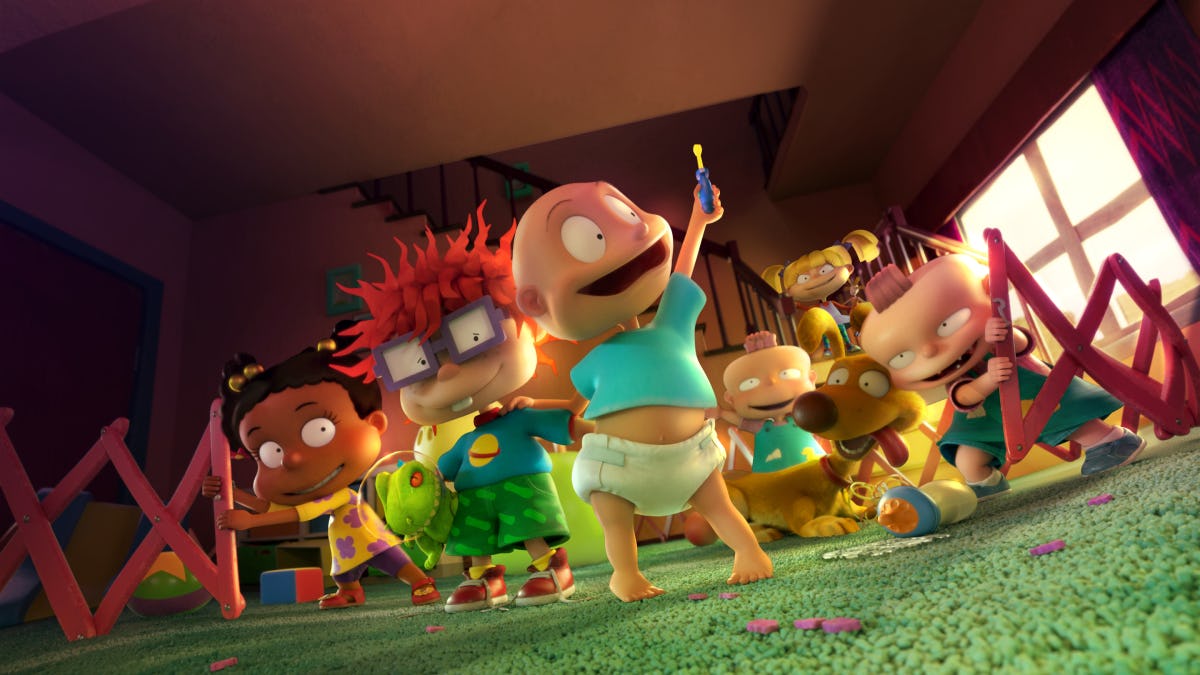
With Pride month just around the corner, and set to cover most cities in more glitter and gag balls than ever before to make up for what 2020 stole, we’re naturally prepared for gay news to start seeping from corners of *the culture* that it doesn’t normally reach. Still, I don’t think we were primed for Rugrats to kick off the Pride month trend. Details are finally trickling out from Nickelodeon on what will be a reboot of the iconic 90’s cartoon for Paramount+.
The images alone of the familiar cast — with a two-decade glow up in animation — are enough to make any millennial wonder if they microdosed accidentally. But the news that Phil and Lil’s mom Betty will be an openy gay character (voiced by queer actor Natalie Morales) in the reboot is the actual head trip we’re applauding. Morales told The A.V. Club, “anyone who watched the original show may have had an inkling Betty was a member of the alphabet mafia.” With the general reaction to Betty’s outting news being, “yeah, duh,” it begs the question: weren’t all of the Rugrats gay icons?
There’s been ruminating on the internet before about Angelica Pickles, top billing villain of the show, being a gay. Some have argued that her sass, confidence and general joie de vivre from being a downright bitch to babies makes her an obvious gold star lesbian. I’d like to say, “nay,” to that though and instead offer that Angelica was a different letter altogether in the mob — she is the sometimes bemoaned, but essential, A for ally.
Angelica is the straight girl at pride who came with her queer friends, but gets the most drunk. Angelica is at the Pride march, but complaining because her feet hurt. Angelica is the one asking her queer friends if they would do her if she were gay, and lamenting that she would be non-bianry if she wanted to be, but someone has to maintain representation for straight femmes in the discourse. Her best friend, and fellow ally, Susie Carmichael is always there to give her a stern, “No, sis,” and she means it. Angelica is loud, covered in glitter and called your dad a homophobe at bottomless brunch. One of her most iconic original quips was, “Sometimes I wish I could be you, so I could be friends with me,” and if that’s not a motto for problematic white allyship, I don’t know what is.
The real lesbian icon of the show was Angelica’s doll Cynthia. No stranger already to queer memes, Cynthia has a chic, gender non-conforming coif, and wears ironically clashing colors, tied together with a fashion forward, masculine belt. She never seems amused by anything, and is a workout fanatic who smokes cigarettes. She will lay in the pool all day nursing one Michelob Ultra and get tanner than everyone — while offering funny one-liners to every conversation without being too much. Cynthia is the queen of je ne sais qoui, that deserves a giant gay chef’s kiss.
It is the babies of the show though that provide a more relatable tableau of queerness today. Throughout the series they were never strangers to dressing outside of their assigned genders, and spoke to a sense of play and not giving a fuck that the LGBTQIA+ culture of Millennials and Gen Z has widely embraced and made more mainstream. Twins Phil and Lil’s matching dresses alone belong in Pride-themed Urban Outfitters ad, and Tommy Pickles’ staple diaper look is straight out of a southern queer summer, posted up by a waterfall in muddy cutoffs wondering if you’re more of a racoon or a possum kind of gay. Chuckie’s step sister Kimi Finster, while not cannon to the orignial show, also deserves a big nod for her fashion-forward looks, and Chuckie certainly fills the archetype of the quieter queer who is still always there to offer balance at the turn up even if it makes him nervous. The finster parents, Chas and Kira, also have a vibe that seems out of a Nico Tortorella and Bethany C. Meyers interview on queer polyamory.
Jokes aside, the prosperity of the 90s seemed to provide a backdrop for ambiguity that went under the radar in a different way than what we know now. Shows like Freaks And Geeks, Pete And Pete and My So Called Life spoke to a kind of un-glossy weirdness that left room to fill in the blanks, and that was no different for the cartoons of the time. Not to say that being gay was in any way easier in the 90s — I’d argue that every generation has queered up the world more and leaves it better for those coming behind them — but there wasn’t so much “triggering” and “cancelling” like there is today. The homophobia was in living rooms, not on Twitter — and while that’s no better, it was certainly different.
The internet has given way to everyone being all up in everyone else’s subcultures, and conservative outcry seems to follow every queer thing that happens in entertainment, even though LGBTQIA+ representation is thankfully far more ubiquitous than it ever has been. Something about the grunge and androgyny that leaked into the punk and fashion worlds allowed for an entertainment landscape in the 90s where we saw that more room for low-key interpretation. While considering the characters of Rugrats to be queer icons is a bit of a tongue-in-cheek projection, the general sense of the show was that the children were more aware of their world and its perils than the parents around them, and left to fend for themselves through friendship and courage. That’s a pretty damn queer outlook, and as Tommy Pickle’s says, “A baby’s gotta do, what a baby’s gotta do.”







